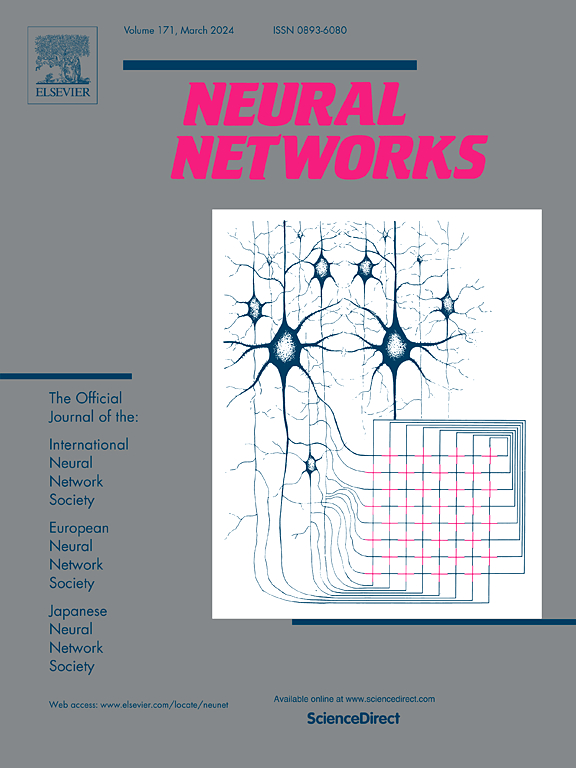Enhancing multiview synergy: Robust learning by exploiting the wave loss function with consensus and complementarity principles
IF 6
1区 计算机科学
Q1 COMPUTER SCIENCE, ARTIFICIAL INTELLIGENCE
引用次数: 0
Abstract
Multiview learning (MvL) is an advancing domain in machine learning, leveraging multiple data perspectives to enhance model performance through view-consistency and view-discrepancy. Despite numerous successful multiview-based support vector machine (SVM) models, existing frameworks predominantly focus on the consensus principle, often overlooking the complementarity principle. Furthermore, they exhibit limited robustness against noisy, error-prone, and view-inconsistent samples, prevalent in multiview datasets. To tackle the aforementioned limitations, this paper introduces Wave-MvSVM, a novel multiview support vector machine framework leveraging the wave loss (W-loss) function, specifically designed to harness both consensus and complementarity principles. Unlike traditional approaches that often overlook the complementary information among different views, the proposed Wave-MvSVM ensures a more comprehensive and resilient learning process by integrating both principles effectively. The W-loss function, characterized by its smoothness, asymmetry, and bounded nature, is particularly effective in mitigating the adverse effects of noisy and outlier data, thereby enhancing model stability. Theoretically, the W-loss function also exhibits a crucial classification-calibrated property, further boosting its effectiveness. The proposed Wave-MvSVM employs a between-view co-regularization term to enforce view consistency and utilizes an adaptive combination weight strategy to maximize the discriminative power of each view, thus fully exploiting both consensus and complementarity principles. The optimization problem is efficiently solved using a combination of gradient descent (GD) and the alternating direction method of multipliers (ADMM), ensuring reliable convergence to optimal solutions. The generalization abilities of the proposed Wave-MvSVM model is theoretically supported through analyses based on Rademacher complexity. Extensive empirical evaluations across diverse datasets demonstrate the superior performance of Wave-MvSVM in comparison to existing benchmark models, highlighting its potential as a robust and efficient solution for MvL challenges. Furthermore, we implemented the proposed Wave-MvSVM model on Schizophrenia dataset, showcasing the model’s efficacy in real-world applications. The source code of the proposed Wave-MvSVM model is available at https://github.com/mtanveer1/Wave-MvSVM.
增强多视图协同:通过利用具有共识和互补原则的波损失函数进行鲁棒学习
多视图学习(MvL)是机器学习的一个前沿领域,利用多个数据视角通过视图一致性和视图差异来提高模型性能。尽管有许多成功的基于多视图的支持向量机(SVM)模型,但现有的框架主要关注共识原则,往往忽略了互补性原则。此外,它们对多视图数据集中普遍存在的噪声、容易出错和视图不一致样本的鲁棒性有限。为了解决上述限制,本文引入了wave - mvsvm,这是一种利用波损耗(W-loss)函数的新型多视图支持向量机框架,专门设计用于利用共识和互补原则。不同于传统的方法往往忽略了不同观点之间的互补信息,所提出的Wave-MvSVM通过有效地整合这两个原则,确保了一个更全面和有弹性的学习过程。w损失函数以其平滑、不对称和有界特性为特征,在减轻噪声和离群数据的不利影响方面特别有效,从而提高了模型的稳定性。从理论上讲,w损失函数也表现出一个关键的分类校准特性,进一步提高了它的有效性。所提出的Wave-MvSVM采用视图间共正则化项来增强视图一致性,并采用自适应组合权策略来最大化每个视图的判别能力,从而充分利用了共识原则和互补原则。采用梯度下降法(GD)和乘法器交替方向法(ADMM)相结合的方法有效地求解了优化问题,保证了算法收敛到最优解的可靠性。基于Rademacher复杂度的分析从理论上支持了Wave-MvSVM模型的泛化能力。对不同数据集的广泛经验评估表明,与现有的基准模型相比,Wave-MvSVM具有优越的性能,突出了其作为MvL挑战的鲁棒高效解决方案的潜力。此外,我们在精神分裂症数据集上实现了所提出的Wave-MvSVM模型,展示了该模型在实际应用中的有效性。所提出的Wave-MvSVM模型的源代码可在https://github.com/mtanveer1/Wave-MvSVM获得。
本文章由计算机程序翻译,如有差异,请以英文原文为准。
求助全文
约1分钟内获得全文
求助全文
来源期刊

Neural Networks
工程技术-计算机:人工智能
CiteScore
13.90
自引率
7.70%
发文量
425
审稿时长
67 days
期刊介绍:
Neural Networks is a platform that aims to foster an international community of scholars and practitioners interested in neural networks, deep learning, and other approaches to artificial intelligence and machine learning. Our journal invites submissions covering various aspects of neural networks research, from computational neuroscience and cognitive modeling to mathematical analyses and engineering applications. By providing a forum for interdisciplinary discussions between biology and technology, we aim to encourage the development of biologically-inspired artificial intelligence.
 求助内容:
求助内容: 应助结果提醒方式:
应助结果提醒方式:


